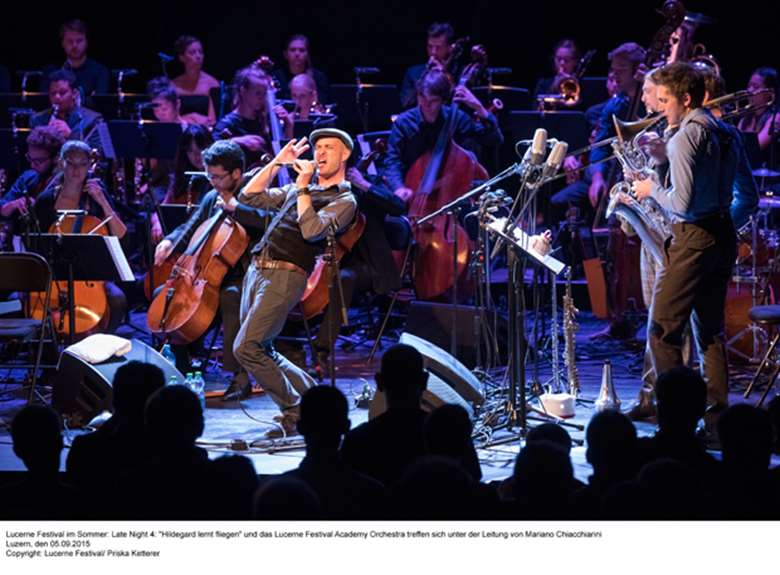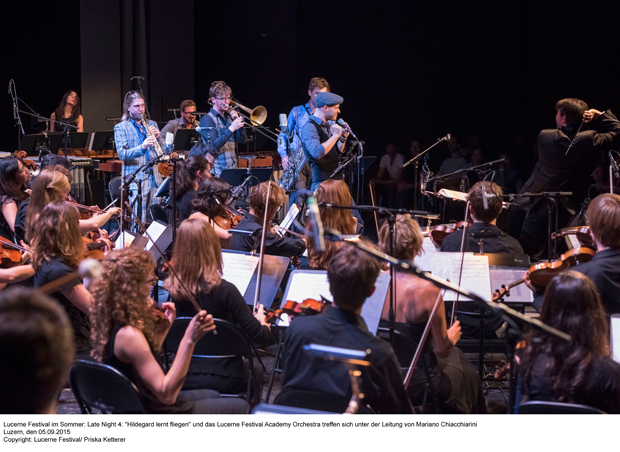Andreas Schaerer interview: learning to fly with Hildegard
Thursday, October 15, 2015
Nick Hasted travelled to Switzerland to this year’s Lucerne Jazz Festival to witness vocalist/composer Andreas Schaerer’s latest project Hildegard Lernt Fliegen taking flight – with its compelling blend of cutting-edge improvisation, jazz swing and contemporary classical music, he discovers it’s been a labour of love to get the project airborne When Andreas Schaerer, the prodigiously driven and talented singer-leader of Hildegard Lernt Fliegen, was rehearsing his most ambitious composition last month, a good omen entered quietly at the back of the room.

“It was funny,” Schaerer reflects, the morning after the performance of his piece. “The clarinetist from that album went to our rehearsal, really admired it, and was pulled back into that moment when they recorded. He said, ‘Boulez was there like you were there, trying to bring the rhythm together, and the orchestra was struggling.’ It was beautiful, magical to have that person there with me.”
The Big Wig combines Hildegard Lernt Fliegen with the Lucerne Festival Academy Orchestra – young as individuals and ensemble, and more open to popular forms than Zappa apparently found the LSO – in a 60-minute, six-movement piece. An audience of diverse Hildegard fans who’ve come to hear it from across Europe make Schaerer, almost as capable of surreal comic flights as musical ones, talk even more than usual, flitting between Swiss-German and English to inclusively recount the giant hurdles that have led to tonight.
The climax of my first startled encounter with Hildegard Lernt Fliegen, this spring at Dublin’s 12 Points Festival, saw Schaerer vocally duetting with trombonist Andreas Tschopp, and exactly matching the instrument’s sound in astonishing improvisatory flights. He seemed to have pushed himself to the limit of a human skill few others had sought. Tonight’s similarly jaw-dropping moment finds him at the heart of the orchestra, replacing Mariano Chiacchiarini on the conductor’s stand, and dropping the baton for coded body-signals to his head, gut or head, as he leads a full orchestral improvisation. When he wrote in the programme of flying too close to the sun, here is where everyone’s wings could have burned. It’s like making a jumbo jet dance, a giddy improbability. Schaerer, hat whipped off and resembling a punk wizard in the potential melee, leads the performance with operatic vocals, even as he enacts the music’s emotional trajectory – “stressed”, but with “open hearts”. The orchestra’s individual players respond with focused glee, stretching imaginative jazz muscles they didn’t know they had.
There are fine, delicate moments in earlier movements, like the rare combination of two harps with Tschopp’s trombone after a gentle Schaerer verse, then singer and violins alternating on two notes, held as perfectly by Schaerer’s vocal chords as the strings, a somehow moving achievement. The jackhammer beat and Schaerer’s thin-air falsetto on ‘Don Clemenza’, and the encore’s rapid-fire, single-note, pizzicato strings trigger an inevitable standing ovation at this otherwise formal classical festival.
The ‘Third Stream’ proposed by Gunther Schuller in the 1950s, though narrowed by recent, academy-schooled jazz generations, is still rarely bridged in a way that does full justice to its classical and jazz sides. The Wayne Shorter Quartet’s 2013 London Jazz Festival gig with the BBC Concert Orchestra, for instance, felt to me like pretty rote orchestrations of Shorter’s work, with the orchestra mostly cluttering the quartet’s more intriguing path. The Big Wig, too, isn’t as thrilling as Hildegard Lernt Fliegen alone, one of the great jazz experiences right now. There’s a sweep to the music but – that mass, mob improv apart – at a cooler, less exhilarating temperature. The visible sparks Schaerer set free in the orchestra, and the different colours and movement he has now wrestled with, were still wholly worthwhile for them and the listener.

Schaerer has Gil Evans’ orchestral work with Miles Evans deep in his DNA, and explored Debussy and Stravinsky as he prepared. The integration of his solos and band into The Big Wig’s performance is certainly nearer Miles’ model than Shorter’s. Over a coffee high up in Lucerne’s museum of art the next afternoon, looking down on the Reuss river, the tired composer considers how things went.
“I’m glad to hear this,” he says, when I admire the musicians’ integration. “I watched quite a few collaborations between jazz musicians and orchestras on YouTube. And I found almost all the time they used the orchestra in a non-rhythmical way, for harmony layers, and this of course is much easier to do, they can do it very fast. But I wanted to have more of this Stravinsky mood, in our time, in our cosmos. That’s why the part we played in the end as a reprise, if you listen to it a few times, you will notice that there are 20 layers above each other. You can focus on the marimba all the time, and you’ll hear different changes happening. Or focus just on what happens in percussion, the dialogue between the castanets and vibraphone and snare drum, which could work as a proper piece. Then at the same time have a little pizzicato thing communicating with the harp. Above this you have lyrics together with plunger trumpets. I hope with this to have several stories happening at the same time, like when you’re out in the city and each one has its story. Like today I’m focused on talking with you in this room, tomorrow it will be someone else. So it is close to our existence, it gives more dimensional layers. My only problem as a composer is I know all these layers and they’re all there, so if one is different...” He makes a noise like staccato static in his brain. “But I have to let it go.”
Rhythm was the problem Schaerer never quite solved. As Duke Ellington could have told him, swing and jazz’s rhythmical life-blood is tough to learn.
“What happened yesterday in the concert,” he says, “the level of quality of the performance, was what I was thinking about. I was happy. I was not disappointed, and I was not too much surprised. But, a huge problem is that we from the jazz side are used to working very rhythmically. This is a huge topic for classical players. And when I composed, I really tried to keep it simple. I tried to avoid as much as possible syncopations and offbeats, and if I did, I always did the offbeat really small, so they had the feeling for it. But still, even though it was much simpler than the music I write usually for my band, it didn’t work really rhythmically on the point. All the classical people I spoke to didn’t notice it. ‘No, it was perfect. It was tight.’ But for me it was not tight. I had to accept, ‘Okay, it’s a different culture.’ But like I said, I have to let it go. Otherwise, I’d go mad.”
Still, an old classical hand reassured him, orchestras, just like jazz bands, need to warm to their task. And as we leave the bar, Schaerer is offered the possibility of more performances of The Big Wig; a chance to fly a bit higher, before the feathers start to singe again.